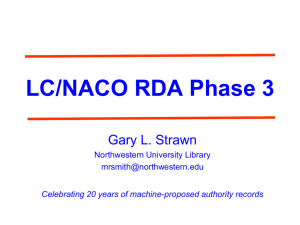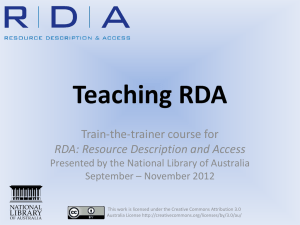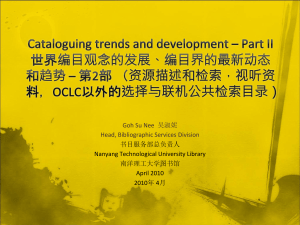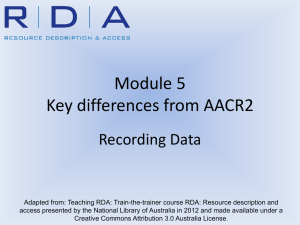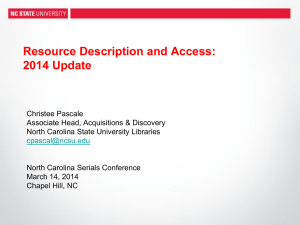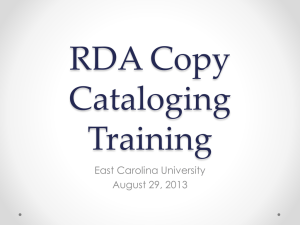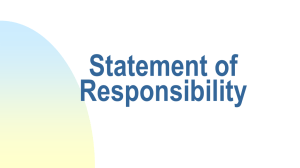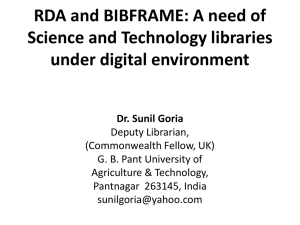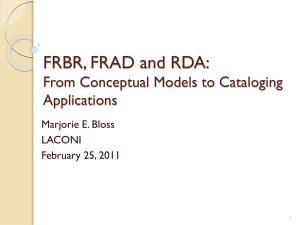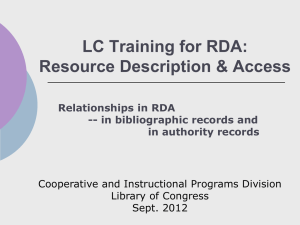RDA - West Virginia Library Association
advertisement
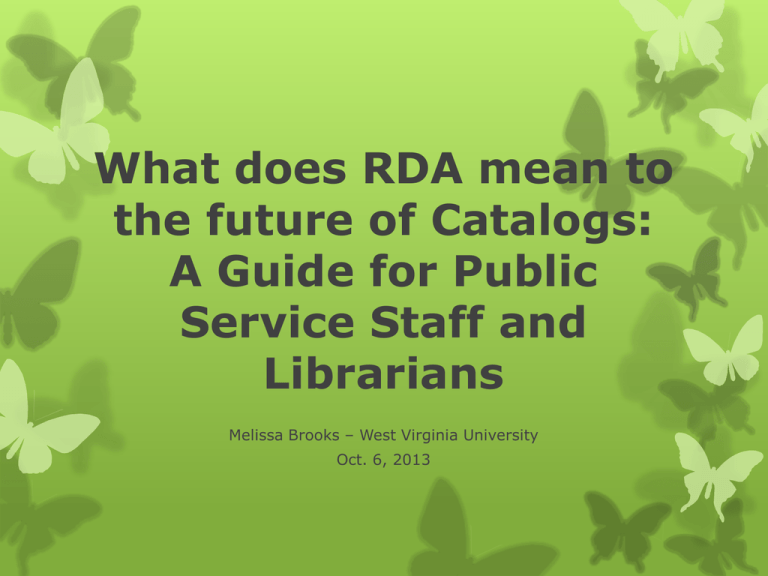
What does RDA mean to the future of Catalogs: A Guide for Public Service Staff and Librarians Melissa Brooks – West Virginia University Oct. 6, 2013 A Little Bit About AACR2 AACR was developed in the 1960s, revised in 1978, with a final revision in 2002. AACR2 was last updated in 2005. (7 years ago) Has two main sections: 1. Description – broken down by chapter for each type of material 2. Access – for the creation of access points within the cataloging of the item A Little Bit About MARC MARC stands for MAchine Readable Cataloging MARC was developed in the late 1960s as a way to enable libraries to share information at a reasonable cost and in a computer readable format MARC is a computerized way of recording information (Metadata) To hold this Metadata, MARC uses Tag Fields to indicate placement of the Metadata Ex. 1xx Tag Field = Main Entry 245 Tag Field = Main Title 250 Tag Field = Edition Statement The future capabilities of MARC were seen as a success for libraries so in a later version MARC21 it took on extra facets to fit the needs of AACR2. Hence why extra Tag Fields are added. Since AACR2 and MARC have worked for so long, WHY Change?? They Don’t Work Any Longer!!! • The Cataloging Rules have become out of date. • They don’t work well with new ways to link metadata. • Also, AACR2 is written in chapter sequence by format of the item. It does not allow for new formats to be added or for combined materials. Example: Playaways, Electronic Resources, MP3s or MP4s, and multi-format items. • Searching has changed. Patrons no longer use a traditional card catalog. They now use ILS systems that allow for keyword searching and some aspects of the semantic web. SO WHAT’S NEXT???? FRBR Functional Requirements for Bibliographic Records It is a conceptual model. (Not a set of Cataloging Rules) Developed in 1997 by IFLA. It is meant to help the patron find, identify, select, and obtain information. (Patron Centric) FRBR is meant to help analyze information into Entities, Attributes of the Entity, and Relationships between Entities. FRBR Relationships: (GROUP 1) Work - (What is imagined by the Creator) is realized through Expression – (How the work is written) is embodied in Manifestation – (The produced work) is exemplified by Item – (This is the physical item on the shelf) FRBR Relationships: (GROUP 1) This concept is know by the Acronym WEMI. Which can sometimes be confused with WAMMY. An Example of FRBR Work Is the intellectual property of the Creator. Hamlet – As thought up by William Shakespeare. Expression The realization of the work. Hamlet – written down in Shakespeare’s hand. An Example of FRBR Manifestation Item The physical embodiment of the work! (Carrier- BOOK) The copy you find on your shelf. WVU’s Copy! FRBR is the start of when Catalogers and Programmers begin to really look at linked data and the future of how catalogs will be structured. So How Will This Conceptual Model Create Structured Metadata? Introducing… RDA – Resource Description and Access • RDA is the new cataloging standard that has been developed by the Joint Steering Committee for Revision of AACR2R. • RDA incorporates the principles of the FRBR conceptual model. • RDA is a living web document/standard. It can easily be updated and modified to meet the changing needs of Cataloging and Metadata. • RDA was fully implemented March 31, 2013 by Library of Congress, OCLC, National Libraries and other libraries have or are beginning to implement as we speak. So what is the difference between AACR2 and RDA – Patron View Bibliographic Record in AACR2 AACR2 contains Abbreviations Use of the c – to signify copyright So what is the difference between AACR2 and RDA – Patron View Bibliographic Record in AACR2 Records contains a GMD (General material designation) Contains abbreviation et. al. So what is the difference between RDA and AACR2 – Patron View Bibliographic Record in RDA Mostly no more use of abbreviations Use of the © symbol instead of c. Addition of Content, Media, and Carrier Types – (MARC 336338 Fields) – Added to All Records instead of GMD for only non-book formats. Addition of a Relator term to Creators Name So what is the difference between RDA and AACR2 – Patron View Bibliographic Record in RDA Statements relating to the publication, printing, distribution, issue, release, or production of a work. (MARC 264 no longer a 260) The information is now separated to allow for better use and easier understanding. So what is the difference between RDA and AACR2 – Patron View Bibliographic Record in RDA Carrier Characteristics This includes information on: • • • • Sound Characteristics Projection Characteristics of Movie Image Video Characteristics Digital File Characteristics These are the 344-347 MARC fields Other Stuff that May be Seen In the Patron View of an RDA Bibliographic Record • Differences in Capitalization - No longer will everything be lower case except for Proper terms and the beginning of titles. Ex. AACRC2 – Legendary locals of Huntington West Virginia / James E. Casto. RDA – LEGENDARY LOCALS OF HUNTINGTON WEST VIRGINIA / JAMES E. CASTO. • No more abbreviations – RDA still allows for some abbreviations like in. for inches. – But all the Latin ones are gone. – So bye-bye: et. al. (et alia), s.n. (sine nomine), or s.l. (sine loco). • cm is a symbol and not an abbreviation, so it will not have a period following unless there is a series title. • Relator terms will now be used to the relation of a person to the particular resource to which they are attributed. Ex. Brandon Brooks – is the producer of a movie, now you will see in an Added Author authority tracing that looks like Added Author: Brandon Brooks, producer. Other Stuff that May be Seen In the Patron View of an RDA Bibliographic Record • Statement of Responsibility – Take it as you see it. If you see Dr. John Smith, University of Edinboro on title page then that is what will appear on Catalog record. • Errors in a title will not have [sic] in title. They will now be written incorrectly and then alternate title will be created. EX. AACR2 – Pushnig [sic] daisies Corrected – Pushing daisies RDA – Pushnig daisies Corrected – Pushing daisies • There will be differences in how the Subject Heading for the Bible will appear Ex. AACR2 – Bible. O.T. RDA – Bible. New Testament • “No” more Rule of Three? – This means that many authors can be listed, we don’t stop at three and they can all be traced for authorities. Example of Statement of Responsibility Name as appears on title page Name as appears in statement of responsibility Example of “NO” Rule of Three There are 6 contributors: Larry Blocher Eugene Corporon Ray Cramer Tim Lautzenheiser Edward Lisk Richard Miles In AACR2 the only Person who would have been listed is Richard Miles and the rest would have been et. al. In RDA they all appear in the Title Entry and all are traced as Added Authors. Also notice the use of relator terms added to each name. Parallel Titles AACR2 Parallel Titles are treated in a tier hierarchy – the first parallel title listed and then any parallel title that is in English. Titles in other languages are not listed after the English Parallel Title. RDA All Parallel Titles can be listed. Parallel Titles – AACR2 Parallel Titles are treated in a tier hierarchy – the first parallel title listed and then any parallel title that is in English. No titles in other languages are listed after the English Parallel Title. Parallel Titles – RDA Title: Män som hatar kvinnor = Los hombres que no amaban a las mujeres = Girl with the dragon tattoo = Les hommes qui n'aimaient pas les femmes / Yellow Bird presenterar ; i samproduktion med ZDF Enterprises, Sveriges Television, Nordisk Film, ZDF ; och Filmpool Stockholm Mälardalen, Film i Väst, Spiltan Underhållning M AB ; producent, Søren Stærmose ; en film av Niels Arden Oplev ; manus [manuscript], Rasmus Heisterberg, Nikolaj Arcel ; regi, Niels Arden Oplev. Other Title: Los hombres que no amaban a las mujeres Other Title: Girl with the dragon tattoo Other Title: Les hommes qui n'aimaient pas les femmes A Little About the Content Type, Media Type, and Carrier Type (336-338 Fields ) Content Type (336) - The form of communication through which a work is expressed. Ex. Notated Music Spoken Word Still Image Text Two-dimensional Moving Image A Little About the Content Type, Media Type, and Carrier Type (336-338 Fields ) Media Type (337) - Media type reflects the general type of intermediation device required to view, play, run, etc., the content of a resource. (Refers to the 007 field position 00.) Ex. Computer Unmediated Video A Little About the Content Type, Media Type, and Carrier Type (336-338 Fields ) Carrier Type (338) - Carrier type reflects the format of the storage medium and housing of a carrier in combination with the media type (which indicates the intermediation device required to view, play, run, etc., the content of a resource). Ex. Volume Videodisc Slide Audio Disc A Little About the Content Type, Media Type, and Carrier Type (336-338 Fields ) The below link will take you Ex. to a document created by Cathy Lamoureaux from the Carnegie Library of Pittsburgh. In this document she breaks down the 336-338 fields into individual sets to show how a specific type of item will be represented in these fields https://skydrive.live.com/view. aspx?resid=7160219E1C1E8 76E!150&app=WordPdf&aut hkey=!AAyi2x45qmdrqTY Music CD 336 Performed music 337 Audio 338 Audio disc DVD 336 Two-dimensional moving image 337 Video 338 Videodisc But the Biggest thing about RDA Bibliographic Records is… They are to live peacefully with AACR2 Bibliographic Records in an ILS. So what is the future of Metadata and Catalogs??? Semantic Web and BibFrame Semantic Web • The Semantic Web is a new way of looking at the Internet and how it is pieced together. • No longer will we be looking at the web as a flat surface of one page linking to the next, but as a bunch of snippets of information that can be pulled together to create new, flexible, and more versatile structures. • The biggest term to remember about the Semantic Web is a ‘TRIPLE.’ This is a way of connecting information together to allow for a more natural language approach to searching. It used principles based on RDF – Resource Description Framework. • You may hear people talking about ‘linked data.’ This is what they are referring to. BibFrame • Bibframe is standard that is being developed by the Library of Congress as a replacement to MARC. • This standard is looking at using the a ‘Linked Data’ model to better utilize Metadata. (Semantic Web) • Currently it is using XML Tagging to create ‘Linked Data’ records. Questions???? Thank YOU!!! References, Links, Resources Brigham Young University, Harold B. Lee Library. (n.d.). Catalog. Retrieved from: http://lib.byu.edu International Federation of Library Associations and Institutions. (2009, February). Functional requirements for bibliographic records. Retrieved from http://www.ifla.org/files/assets/cataloguing/frbr/frbr_2008.pdf James Madison University Libraries. (n.d.). Catalog. Retrieved from http://catalog.lib.jmu.edu/search/X Lamoureaux, C. (2013, April 13). RDA – Content, media and carrier type values for various types of resources. Retrieved from https://skydrive.live.com/view.aspx?resid=7160219E1C1E876E!150&app=WordPdf&authkey=!AAyi2x45qmdrqTY 3 Miller, L. (2011). Resource Description and Access (RDA): An introduction for reference librarians. Reference & User Services Quarterly, 50 216-222. Retrieved from http://rusa.metapress.com/content/u771g5f12313 Morehead State University, Camden-Carroll Library. (n.d.). Catalog. Retrieved from http://www.moreheadstate.edu/library/ Palmer, S. (2001). The semantic web: An introduction. Retrieved from http://infomesh.net/2001/swintro/ Schiff, Adam. (2011, February 18). AACR2 to RDA. Retrieved from http://faculty.washington.edu/aschiff/AkLAPresentation-WithNotes.pdf University of Cincinnati Libraries. (n.d.). Catalog. Retrieved from http://uclid.uc.edu University of Tennessee Libraries. (n.d.). Catalog. Retrieved from http://www.lib.utk.edu/ U.S. Library of Congress & Zepheira. (n.d.). New bibliographic framework. Retrieved from http://bibframe.org U.S. Library of Congress. Net work Development and MARC Standards Office. (n.d.). MARC format for bibliographic data. Retrieved from http://www.loc.gov/marc/bibliographic/ecbdhome.html West Virginia University. Downtown Library. (n.d.). Catalog. Retrieved from http://www.libraries.wvu.edu/

